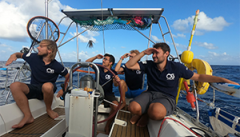
Research
Plastics, man and the sea
« Homme libre, toujours tu chériras la mer !
La mer est ton miroir1 »
'Free man, you will always love the sea! The sea is your mirror’ 1
For nine months, they sailed across the North Atlantic. Between crazy dreaming and scientific awareness, four students from the Rhone-Alpes region had hoisted the mainsail from Concarneau to the West Indies, crossing the 7th continent, ‘the plastic monster’. A phenomenon symptomatic of a proven environmental emergency, the continent of plastics is still poorly known. On the occasion of World Oceans Day, Guillaume Marcelin, crew member and student at INSA Lyon, looks back on his trip. Let's turn to a sad reality.
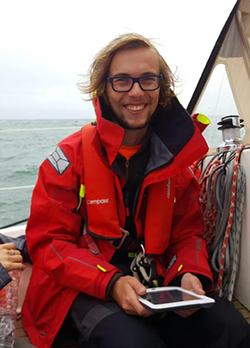 June 2018. On board the ‘Researcher’, Guillaume Marcelin, a fifth-year student in the computer science department at INSA Lyon, Cédric and Grégoire, students at ENS Lyon, and Adrien, from Ensimag-INP Grenoble, are embarking on a crazy adventure: crossing the North Atlantic to study the impact of plastic pollution. From Brittany, heading for the Azores and then the West Indies, the student crew spent nine months on a 35-foot 2 sailing boat. ‘The ExploraGyre project was born thanks to a childhood friend studying at the ENS. I knew nothing about the maritime world! I trusted the captain because at the time, it was above all the madness of the project that attracted me. In the beginning we wanted to sail, and naturally we gave this trip a scientific dimension. The ocean is full of beauty, but it is also the first victim of global warming’, explains Guillaume Marcelin.
June 2018. On board the ‘Researcher’, Guillaume Marcelin, a fifth-year student in the computer science department at INSA Lyon, Cédric and Grégoire, students at ENS Lyon, and Adrien, from Ensimag-INP Grenoble, are embarking on a crazy adventure: crossing the North Atlantic to study the impact of plastic pollution. From Brittany, heading for the Azores and then the West Indies, the student crew spent nine months on a 35-foot 2 sailing boat. ‘The ExploraGyre project was born thanks to a childhood friend studying at the ENS. I knew nothing about the maritime world! I trusted the captain because at the time, it was above all the madness of the project that attracted me. In the beginning we wanted to sail, and naturally we gave this trip a scientific dimension. The ocean is full of beauty, but it is also the first victim of global warming’, explains Guillaume Marcelin.
Crossing the ocean to study plastic pollution, yes. But on board a safe and sustainable ship. ‘By raising funds through our association, Oceasciences, we managed to reconfigure the security elements of the Researcher, which dated from 1992 and was not intended for the high seas. Solar panels provided the energy used for navigational instruments and scientific experiments. We also installed a water recovery system for our daily use. We left with the bare necessities and rather weak equipment’, admits Guillaume, the project's technical manager. ‘When the autopilot failed us, we had to find backup solutions so that we didn't exhaust ourselves at the helm for ten hours of sailing. The key word was resourcefulness, but in the marine world, mutual aid is very important. These meetings with seafarers and fishermen have enabled us to raise their awareness of the environmental cause’.
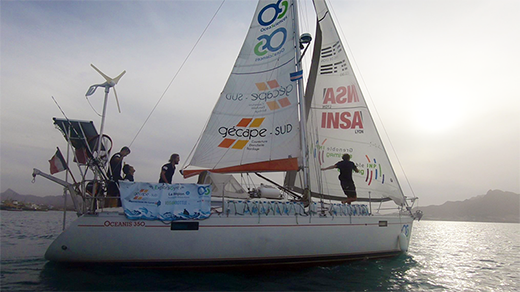
At the stern of the Researcher, navigating in the ship's tracks, two buoys overhanging a manta net: in order to determine the concentration and different types of micro-plastics present in the water, the crew left the measuring tool behind. Similar to a large sock, the fine-mesh net caught small particles as they passed through the water, which the scientific crew collected and incorporated into their analysis on their return to France. ‘Collection, when weather conditions allowed the net to be cast, was always terrifying. It was made up of small elements, which looked like pebbles or pieces of mother-of-pearl. In reality, it is plastic waste that disintegrates under the effects of friction, current, wind and the sun's radiation’, explains Guillaume. Deceptive and invisible, plastic pollution reaches into every corner of planet earth, right down to the seas and oceans. Every year, approximately 4 and 12 million tonnes of plastic are discharged into the water. Sometimes as large as plankton, fish ingest this plastic debris and find themselves contaminated, as the students' research shows. ‘The other important part of our scientific journey consisted of catching fish, first for our personal consumption and then for our research. It was a question of dissecting them and analysing the inside of their stomachs. We noted that 24% of the fish caught were contaminated by plastic particles’, notes the student sadly.
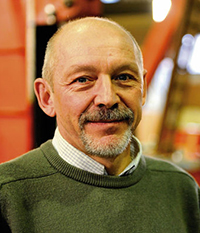 By accumulating in the heart of the oceanic gyres, these eddies of ocean currents, the plastic waste from human activity is dispersed in our oceans, so plentiful that it forms real continents. From dry land to the bottom of the sea, how could this be possible? For Bernard Chocat, Professor Emeritus at INSA Lyon and a specialist in sustainable water management, the equation is simple. ‘All it takes is a gust of wind or rain for the cigarette butt3 you have just thrown away to end up in a river and then the sea. We tend to think that the sewerage grids of our cities are capable of swallowing anything and everything, because when it reaches the network, the waste clogs the sewage treatment system, which overflows. The problem is the same for a wipe or a cotton swab flushed down the toilet. Treated in a unitary network, rainwater and domestic water are collected and disposed of in the same network. However, the capacity of our treatment plants is not suited to intense flows on very rainy days, for example. The excess waste water is disposed of by storm overflows, directly to the natural environment where our waste is not filtered. In the case of a separate treatment network, rainwater, and therefore the butt thrown on the ground, is transported directly to the natural environment’, warns the Professor Emeritus, drawing attention to the importance of everyone's actions in reducing the consumption of plastic waste on a daily basis.
By accumulating in the heart of the oceanic gyres, these eddies of ocean currents, the plastic waste from human activity is dispersed in our oceans, so plentiful that it forms real continents. From dry land to the bottom of the sea, how could this be possible? For Bernard Chocat, Professor Emeritus at INSA Lyon and a specialist in sustainable water management, the equation is simple. ‘All it takes is a gust of wind or rain for the cigarette butt3 you have just thrown away to end up in a river and then the sea. We tend to think that the sewerage grids of our cities are capable of swallowing anything and everything, because when it reaches the network, the waste clogs the sewage treatment system, which overflows. The problem is the same for a wipe or a cotton swab flushed down the toilet. Treated in a unitary network, rainwater and domestic water are collected and disposed of in the same network. However, the capacity of our treatment plants is not suited to intense flows on very rainy days, for example. The excess waste water is disposed of by storm overflows, directly to the natural environment where our waste is not filtered. In the case of a separate treatment network, rainwater, and therefore the butt thrown on the ground, is transported directly to the natural environment’, warns the Professor Emeritus, drawing attention to the importance of everyone's actions in reducing the consumption of plastic waste on a daily basis.
Crossing the Atlantic, the ultimate mission of the four students on the Researcher's crew was to raise awareness. By engaging with different audiences, through scientific and ecological approaches. ‘We met students in the West Indies, in schools and alliances françaises. Two schools in the Lyon region, in Givors and Fitilieu, also followed our adventures on a daily basis. During the trip, we also did some advocacy work in ports and markets and then we raised awareness among the sailors we met on a daily basis of the fact that fishing is also a major source of plastic waste. Understanding how waste ends up in the ocean is certainly the first step towards being able to avoid causing this pollution ourselves’, adds Guillaume.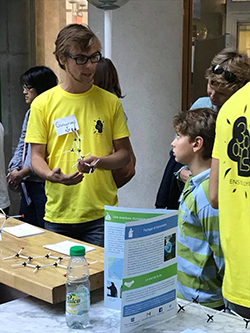
If the end of the journey was a delicate one for the four crew members, the return to dry land left them with a taste for change. ‘After nine months, with four people in a monohull a few metres long, there was tension. We just wanted to go home. But everything we had seen and experienced during those months had given us the direction of what we wanted to accomplish on our return: to help change the situation’, concludes the INSA Lyon student.
Should the ocean be left to rest? [Pop'sciences Forum]
On the occasion of World Oceans Day on 8 June, the University of Lyon organised a series of conferences on the future of the sea bed.
1 Charles Beaudelaire, Les fleurs du mal, Paris, Éditions Michel Lévy Frères, 1868, p. 105.
2 10 metres long
3 The filter of a cigarette butt is usually made of cellulose acetate, a plastic material.
Keywords (tags)
News list
Une délégation de haut niveau de l’Université Beihang reçue à l’INSA Lyon

